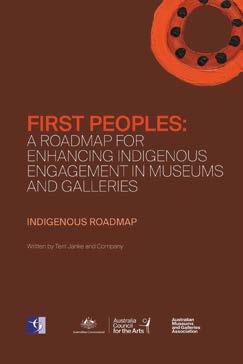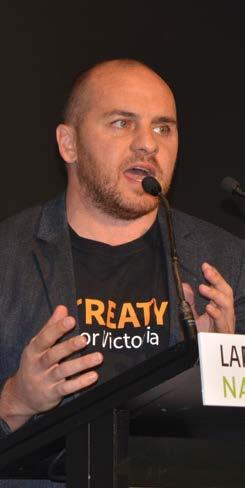
9 minute read
Treat y talk at Native Title Conference
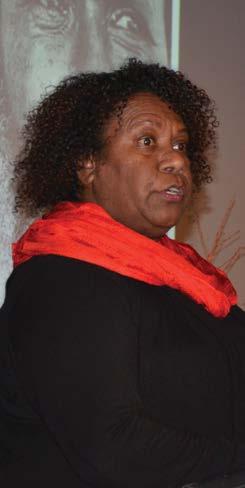
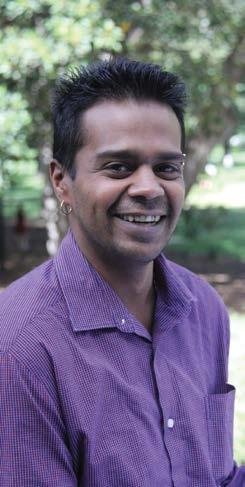
Advertisement
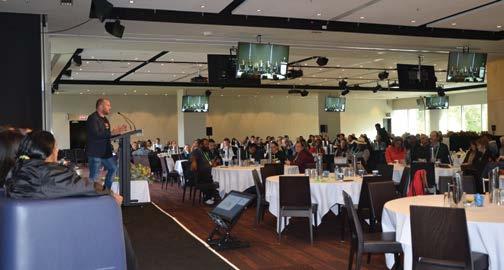
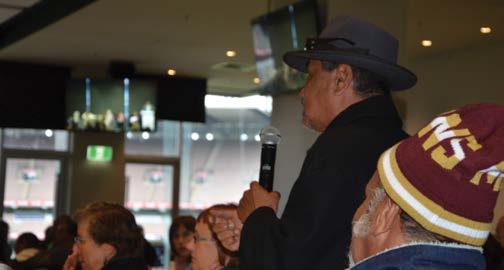
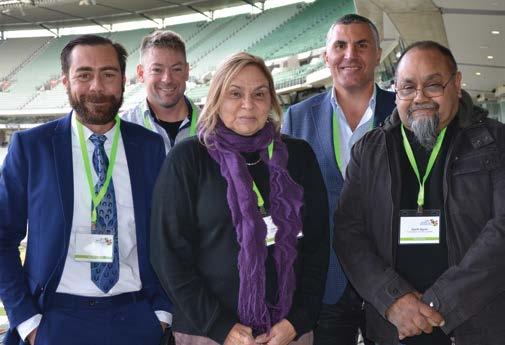
Above, left to right from top left: Jamie Lowe; Gail Mabo; Dylan Clarke; Jamie Lowe addresses the conference delegates; Discussion at the conference; First Nations SA directors Josh Haynes, Travis Thomas, Lorraine Merrick and Garth Agius with Jason Mifsud, Chairman, Federation of Victorian Traditional Owner Corporations at the MCG for the Native Title Conference. The Native Title Conference held in Melbourne in June this year highlighted land rights, treaty and constitutional recognition.
The conference brought together native title delegates and land rights leaders as well as other stakeholders from across the country.
Jill Gallagher, a Gunditjmara woman from Western Victoria and Victorian Treaty Advancement Commissioner, spoke on Mabo Day about how treaty can enhance existing land rights structures.
“The treaty process in Victoria builds on existing systems of land rights recognition, this includes through the native title process, and our state equivalent, which is the Traditional Owners Settlement Act. As well as our system of recognising management of Aboriginal cultural heritage.
“Treaty is not about re-inventing the wheel, it’s about continuing to strengthen those processes that already exists. Our [treaty] structure recognises the decades of struggle that our mob, that our communities have gone through to seek state recognition. The [treaty] structure guarantee any nation that has achieved recognition through any of these processes to have a voice at the table” she said.
Keynote speakers included Mark Smith and Sashia Leung from the British Columbia Treaty Commission who spoke about the experiences of treaty making; its challenges and successes in British Columbia.
Mr Smith said treaties have not had a negative impact on their nation.
“What we have found in British Columbia is that the sky has not fallen with treaties.
“In fact, they have resulted in prosperity for the entire region where treaties have been included, Aboriginal and nonAboriginal. And they have strengthened the governments of Canada, not weakened it, with another order of Indigenous government” he told the Federation of Victorian Traditional Owner Corporation.
Dylan Clarke, Chair of Berangi Gadjin Land Council in Victoria told Aboriginal Way how the conference was an opportunity for knowledge sharing and reviewing existing land rights structures.
“In a sense these couple of days have been about truth telling and hearing from other traditional owners from across the country about their experiences and looking at other ways that we can leverage multiple agreements and strengthen our position as Aboriginal people to take care of our country.
Mr Clarke said, “bringing everyone together to share our knowledge is quite powerful”.
“I sense a renewal of energy in the room because there’s some limitations around some of the structures that we are under and these sorts of conversations that happen really show you that there are some light at the end of the tunnel and nothing really is impossible and we can really achieve what we want for our people and our community.
“So it’s a really strong message that I’m getting from all tradtional owners here that we’re here for the same reason, we’re here to talk about Native Title and all the other structures and systems but let’s talk about how we can get around some of those challenges and work together as a nation” said Mr Clarke.
Jamie Lowe, Chair of the National Native Title Council and conference co-host said the conference was important as it gave opportunity to progress the bigger conversations on a national level.
“It’s a pretty big continent that we live on and to have these kinds of conversations it is difficult to do so when people live in different pockets of the continent, so to bring people together in this way to have these conversations about native title and treaties and land rights and recognition is extremely important.
“There is a momentum building from these conversations and you have seen that in history and the Uluru Statement from the Heart that when we come together we largely agree on the issues and the political way to move forward. So, it’s very important that we come together and consolidate” said Mr Lowe.
Commissioner Gallagher said to establish a voice to parliament will be a challenge for First Nations.
“At a national level we to continue to see discussions about a voice to parliament and what that might look like. But we continue to be at the mercy of the politics of the day, and that’s nothing new for our people and it is frustrating, but we will all continue to fight as that’s what we’ve always done” she said.
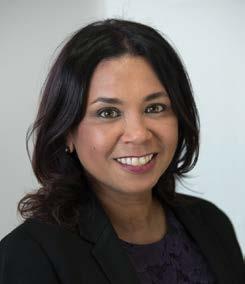
A new report prepared by Indigenous lawyer Terri Janke (pictured above) lays out a detailed plan for Australia’s museums to better engage with Indigenous people.
The report First Peoples: A Roadmap for enhancing Indigenous Engagement in Museums and Galleries was written for the Australian Museums and Galleries Association and recommends ways to increase Indigenous engagement and employment in Australia’s museums and galleries.
According to lead author, Indigenous intellectual property expert and lawyer Terri Janke, the first step to reach this goal is to acknowledge the truth of the past relationship between Australia’s museums and Indigenous people.
“The roadmap addresses representation and basically re-imagining that so that there’s more truth telling and that there are more Indigenous voices in museums and galleries” Ms Janke told Aboriginal Way.
“In the past, representations of Indigenous peoples in museums has been very colonial and represented very one-sided views of Australia’s history.”
That approach to collection and representation has had real impacts on Indigenous cultures she said.
“A lot of material held in the museums and galleries in Australia has been collected a lot without proper provenance, that is Indigenous peoples not knowing that it was taken. The collection of materials did not provide information about the source often, so there’s a lot of material that has been put in collections that we don’t know the provenance of.
“The representation is very ethnographic and collected from a point of view of colonial representation. So Indigenous peoples’ voices, Indigenous peoples’ continuing connection to the cultural material has not remained intact. Increasing Indigenous Opportunity includes compensating and valuing Indigenous knowledge to increase retention of Indigenous staff, as well as increasing support for Indigenous staff to access executive positions and professional development opportunities.
Two Way Caretaking of Cultural Material calls for museums and galleries to creating agreements with Indigenous communities to ensure their collections are being cared for the way they want and to train Indigenous communities to look after their cultural material.
Connecting with Indigenous Communities focuses on providing Indigenous communities with the tools to properly repatriate their material, which could come in the form of outreach programs or collaborations. It calls for more support for Keeping Places and sharing cultural advisors.
Ms Janke said that this comprehensive approach, along with a ‘critical pathways’ map for the execution of the elements, aims to create significant change in the ways museums and galleries do business by the year 2029.
“It’s really trying to put everyone on a pathway so that we can get to a position where Indigenous values are embedded in the sector and that there is much more representation of Indigenous people, Indigenous voices.
“Also that the Australian cultural relationship between Aboriginal and Torres Strait Islander people and nonIndigenous people is reflected in our cultural institutions.
“A key part of that new relationship is creating an understanding that Indigenous cultures still exist as living, ongoing cultures” she said.
“Australians need to see the living vibrant culture of Indigenous people, and the fact that that objects in museums aren’t just things that are locked in time, they are living things that unlock culture, identity, and that continuing connection for Indigenous people.
“That is why this road map will be important for changing the history of our relationship” Ms Janke said.
APY Art Centre Collective
On 17 May 2019, a large crowd joined the APY Art Centre Collective for the opening of a new Anangu artist-owned gallery in Adelaide. This unique space will exhibit and celebrate the work of young and emerging APY artists and provide support to Anangu artists in Adelaide to access medical services and health care. “Work has been underway on making changes in the museums industry for several decades now” Ms Janke said “but it is now picking up pace.
“The Australian Museums and Galleries Association has been looking at this issue for 30 years, and in the ’90s they started doing policy on Aboriginal and Torres Strait Islander issues.
“But the real impetus for these changes is that Indigenous people are understanding now the importance of these collections for reclaiming their cultural connection and their Indigenous cultural and intellectual property.
“Increasing calls for the repatriation of ancestral remains also plays a part in the need for a new approach.
“It’s also the fact that a lot of collections held ancestral remains. Indigenous people have been calling for the return of our ancestors for many years.
“Increasing Indigenous employment in museums and galleries is driving change of its own” Ms Janke explained to Aboriginal Way.
“I also think recently there are more Indigenous people working in the sector and that is driving some of this.
“We have Aboriginal and Torres Strait Islander curators in the sector who are now getting much more opportunity to see what’s in the collections.
“The Roadmap sets out a concrete plan for the next ten years and aims to see substantial changes in the way that Indigenous collections and cultures are presented.
“We want to see more truth-telling exhibitions, but also more collaborations where Indigenous values are seamlessly flowing through the institutions that contain so much of Indigenous cultural content” Ms Janke said.
The report has a focus on five key elements for change.
They are Reimagining Representation, Embedding Indigenous Values into Museum and Gallery Business, Increasing Indigenous Opportunity, Two-Way Caretaking of Cultural Material and Connecting with Indigenous Communities.
Reimagining Representation includes acknowledging the role museums and galleries played in colonisation and increasing exhibitions that involve acknowledgement of Indigenous knowledge and truth telling.
Embedding Indigenous Values into Museum and Gallery Business includes developing Reconciliation Action Plans and making shifts in policy updates, interpretation guidelines and budgeting. Additionally, it calls for Indigenous voices on boards and cultural competency training.
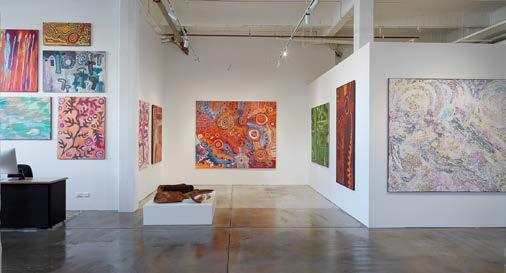
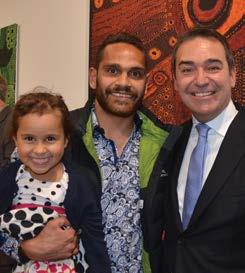
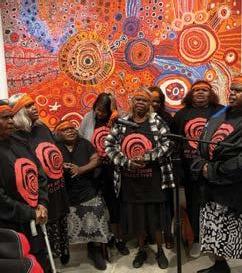
Above: The new APY Art Gallery in Adelaide; The Premier Steven Marshall with Dominic Cassissi and daughter; APY Art Centre Collective members sing to open the new gallery. For more information visit www.amaga.org.au
